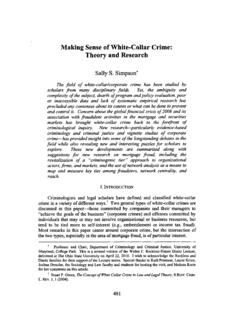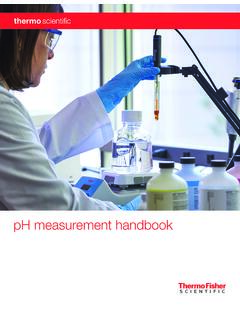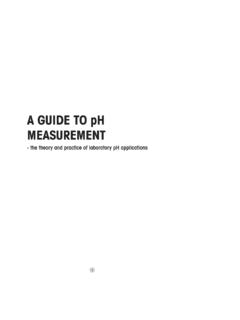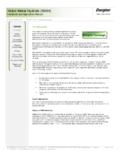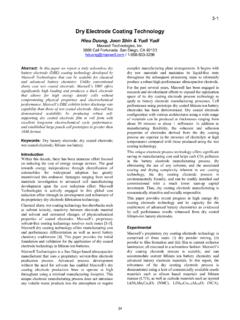Transcription of Charge and Discharge Characterization of Lithium-ion ...
1 Charge and Discharge Characterization of Lithium-ion electrode Materials Through Coin Cell Testing An Undergraduate Honors Thesis Department of Mechanical Engineering The Ohio State University Jiahui Liu Spring, 2015 Dr. Marcello Canova, Advisor ii Abstract Lithium-ion batteries play a fundamental role in the development and commercial success of electric vehicles, due to their higher Charge and Discharge efficiency, and their high energy density. On the other hand, significant research challenges are still present, for instance understanding and mitigating the degradation processes that lead to capacity and power fade in batteries, as well as prototyping and characterizing new materials for improving the energy density, safety, and reduce costs. In this scenario, coin cell testing is a very important experimental technique to analyze the performance of Lithium-ion batteries, and collect data to develop and verify behavioral models that can describe the charging and discharging dynamics and the voltage response of the battery in presence of variable input current.
2 The proposed research project focuses on studying the process of analyzing the charging/discharging performance of Li-ion cell electrode materials through coin cell fabrication and half-cell testing. By analyzing the experimental data, important information can be found on the charging and discharging performance and efficiency of the cell. In addition, the dynamics of the lithium transport process can be assessed, as well as its dependence on usage and environmental factors such as C-rate, State of Charge (SOC) and temperature. This study will provide quantitative information on the physical and chemical properties of electrode materials, and improve our understanding on how such materials can improve the energy density, safety, and reduce costs of Lithium-ion batteries. iii Acknowledgements I would like to thank Dr. Marcello Canova for being my advisor on this project.
3 He introduced me to the project and has helped to guide me towards completion of the project, even with the multiple obstacles we have faced. With his extremely busy schedule, he still chose to meet with me on a regular basis and provided important feedback and direction in order to guide me towards successful completion of this project. I would also like to thank Alex Bartlett for his guidance in the lab and feedback on this project. He helped with experimental design, gave valuable knowledge on coin cell fabrication and testing. In addition, I would like to thank the Ohio State Center for Automotive Research for allowing me to do my research at its facilities. iv Table of Contents Abstract .. ii Acknowledgements .. iii Chapter 1: Introduction .. 1 Motivation for Li-ion battery research .. 1 Objective .. 3 Chapter 2: Background .. 4 Definitions .. 4 Basic operating principles of Li-ion Batteries .. 5 Introduction to Charge and Discharge testing.
4 7 Overview of formation cycles .. 8 Chapter 3: Experimental setup .. 9 Equipment for cell fabrication and Characterization .. 9 Coin cell fabrication procedure .. 13 Preparing and Cleaning .. 13 Assembly .. 15 Formation cycling procedure .. 16 Chapter 4: Results and Discussion .. 18 Description of capacity test .. 18 Result of capacity test for cell #1 .. 19 Result of resistance calculation for cell #1 .. 25 Results for cell 2-5 .. 27 Results summary for all cells .. 32 Chapter 5: Conclusion and Future Work .. 36 References .. 37 v List of Figures Figure 1 The Ragone Plot for Various energy storage devices [6] .. 2 Figure 2 Schematic diagram of a Li-ion cell [7] .. 6 Figure 3 Example voltage curves for different Discharge rates [7] .. 7 Figure 4 Example of constant-current and constant-voltage charging curve profile .. 8 Figure 5 Precision Disc Cutter (MTI) .. 9 Figure 6 Ultrasonic cleaner (Branson 1510 DTH) .. 10 Figure 7 Vacuum oven (VWR Symphony) [11].
5 10 Figure 8 Glovebox (MBraun LABstar) [11] .. 11 Figure 9 Compact Hydraulic Crimping Machine ( MTI MSK-110) [12] .. 11 Figure 10 Coin Cell Cycler (Arbin), with environment chamber (CSZ).. 12 Figure 11 Specification of Arbin Coin Cell Cycler .. 12 Figure 12 Components of coin cell [13] .. 15 Figure 13 the setting for the formation cycling .. 17 Figure 14 Current and Voltage profile during charging and 18 Figure 15 Charging profile for cell 1, cycle #1 .. 19 Figure 16 Discharging profile for cell 1, cycle #1 .. 20 Figure 17 Extrapolated charging data for cell 1, cycle #1 .. 21 Figure 18 Extrapolated discharging data for cell 1, cycle #1 .. 22 Figure 19 Capacity vs. Cycle 33 Figure 20 Charging resistance vs. Cycle number .. 33 Figure 21 Discharging resistance vs. Cycle number .. 33 vi List of Tables Table 1 Initial and final condition for charging and discharging (cell 1) .. 23 Table 2 Mean and standard deviation of initial voltage condition, based on Table 1.
6 23 Table 3 Capacity vs. cycle number for Cell 1 .. 25 Table 4 Charging resistance of cell #1 .. 26 Table 5 Discharging resistance of cell #1 .. 26 Table 6 Initial and final condition for charging and discharging (cell 2) .. 28 Table 7 Initial and final condition for charging and discharging (cell 3) .. 28 Table 8 Initial and final condition for charging and discharging (cell 4) .. 28 Table 9 Initial and final condition for charging and discharging (cell 5) .. 28 Table 10 Mean and standard deviation of initial voltage condition, based on Table 6 .. 29 Table 11 Mean and standard deviation of initial voltage condition, based on Table 7 .. 29 Table 12 Mean and standard deviation of initial voltage condition, based on Table 8 .. 29 Table 13 Mean and standard deviation of initial voltage condition, based on Table 9 .. 29 Table 14 Capacity vs. cycle number for Cell 2 .. 30 Table 15 Capacity vs. cycle number for Cell 3 .. 30 Table 16 Capacity vs. cycle number for Cell 4.
7 30 Table 17 Capacity vs. cycle number for Cell 5 .. 30 Table 18 Charging resistance of cell #2 .. 31 Table 19 Discharging resistance of cell #2 .. 31 Table 20 Charging resistance of cell #4 .. 31 Table 21 Discharging resistance of cell #4 .. 31 Table 22 Charging resistance of cell #5 .. 32 Table 23 Discharging resistance of cell #5 .. 32 Table 24 Mean and standard deviation of capacity for each cycle .. 34 Table 25 Mean and standard deviation of charging resistance for each cycle .. 34 Table 26 Mean and standard deviation of discharging resistance for each cycle .. 35 1 Chapter 1: Introduction Motivation for Li-ion battery research The large of number of automobiles currently in use around the world have caused and are still causing serious problems such as air quality, global warming and depletion of primary energy resources. Because of the rapidly increasing fuel costs and stringent emissions standards, it is necessary to develop a safe, clean and highly efficient transportation [1].
8 To meet the revolutionary challenge, major automotive manufacturers release the hybrid and electric vehicles onto the market. Toyota launched Prius in 1997 [2], still today, it is first electrified vehicle on the market. And Tesla Model S was named Motor Trend s Car of the Year introduced in 2012 [3]. Currently, Lithium-ion batteries are the solution of choice for hybrid and electric vehicles due to the high energy density and long life cycle [4]. Specific power is the maximum power available per unit mass, and determines battery weight for a given power target. Specific energy is the nominal battery energy per unit mass which determines battery weight to achieve an electric range. As seen in Figure 1, Li-ion Batteries cover a wider range of specific energy and specific power while compared to other battery types. In a hybrid electric vehicle, a battery pack is used to provide propulsion along with the internal combustion engine, while in an electric vehicle, the battery pack provides all the power.
9 The battery pack is charged and discharged repeatedly during vehicle operation. 2 Figure 1 The Ragone Plot for Various energy storage devices [6] However, there are some limits in the current battery technologies that pose constrains to the performance of electric vehicles, such as the driving range, as well as to the high purchase and warranty costs. It has been estimated that a reduction of 30% in the costs and an increase of energy density of two times over the current state of the art will be needed to facilitate a larger penetration of electric vehicle in the market [5]. In order to satisfy the above requirements, it is critical to find ways to improve the performance of Lithium-ion batteries and to reduce their production costs, for instance through the development of new electrode materials. This project will focus on characterizing the Charge / Discharge Characterization of Lithium-ion battery materials to understand how their performance correlates with usage conditions and environmental factors.
10 It is expected that this research will provide quantitative information on the physical and chemical properties of electrode materials, and improve our understanding on how such materials can improve the energy density, safety, and reduce costs of Lithium-ion batteries. 3 Objective The purpose of this research is to determine the Charge / Discharge behavior of electrode materials for Lithium-ion batteries using coin cell testing. Specifically, the proposed research objectives include: Fabricate half cells of Lithium Iron Phosphate coin cell using cathode materials harvested from A123 cells to study the Charge and Discharge behavior. Use the instruments at OSU-CAR to test Lithium-ion coin cells prototypes focusing on the formation cycling and capacity assessment. Cycle coin cells and measure relevant parameters including capacity, resistance, state of Charge and open-circuit voltage, to understand the Charge and Discharge behavior for each individual cell.







